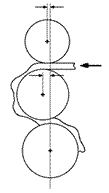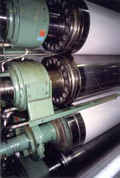|
Calender Barring - Self Excited Vibration
Causes Excessive Maintenance
Calender barring is a vibration problem which not
only affects paper quality, but also the life of the calender rolls.
When serious enough it also causes severe noise, with negative effects on worker health
and safety.
Calender
barring is a self-excited vibration, which means that energy from the
drive is converted to vibrational energy. For this to occur a vibration
feedback mechanism must exist where the vibration is sustained. The
mechanism can be caliper variation induced in the upper nips of the
calender stack, forcing the lower nips to vibrate, or it can be barring
patterns worn into the calender rolls. Both mechanisms can also work simultaneously.
 |
The manner in which caliper variation induced
in an upper nip feeds back into a lower nip can be compared to the way
a swing works in a back yard. When the swing is pushed in phase with
its movement, the swing goes higher. When it is pushed against its
movement, the swing very quickly stops moving. In a similar manner, if
a calender roll is offset to change the nip-to-nip wrap distance, the
caliper can push against the roll vibration and stop the vibration
tendency. If the calender roll is in just the wrong position the
vibration will be amplified and create problems. |
The first step in solving calender barring is to perform offset calculations on the calender stack. These
predict the individual calender roll offsets from the centerline to minimize the vibration. This
procedure often gives good results. At other times the results are less
than ideal, due to some of the assumptions inherent in this procedure
being violated. When this happens an in-depth study is suggested.
Customers have compared the performance of our offset
recommendations with other vendors and have found that ours give better
results.
Willie Pruys from Fort Frances says:
Our stack has had a barring problem for as long as we
can remember. Finally we asked Jake Zwart of Spectrum Technologies to
recommend offsets for our stack. After installing the offsets using
these recommendations, we have run our stack under a
variety of operating conditions, changing both grade and speed. The
stack has been running very smoothly since that time, without a trace
of barring. We are really satisfied, and when it comes time to change
the next stack in this mill, I will be pushing to have Jake calculate
offsets for it.
|

